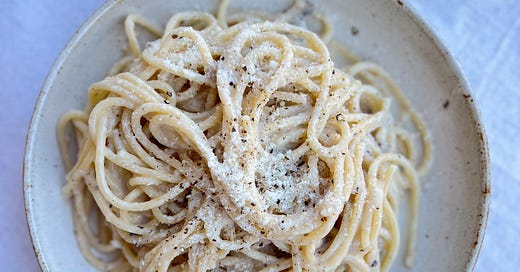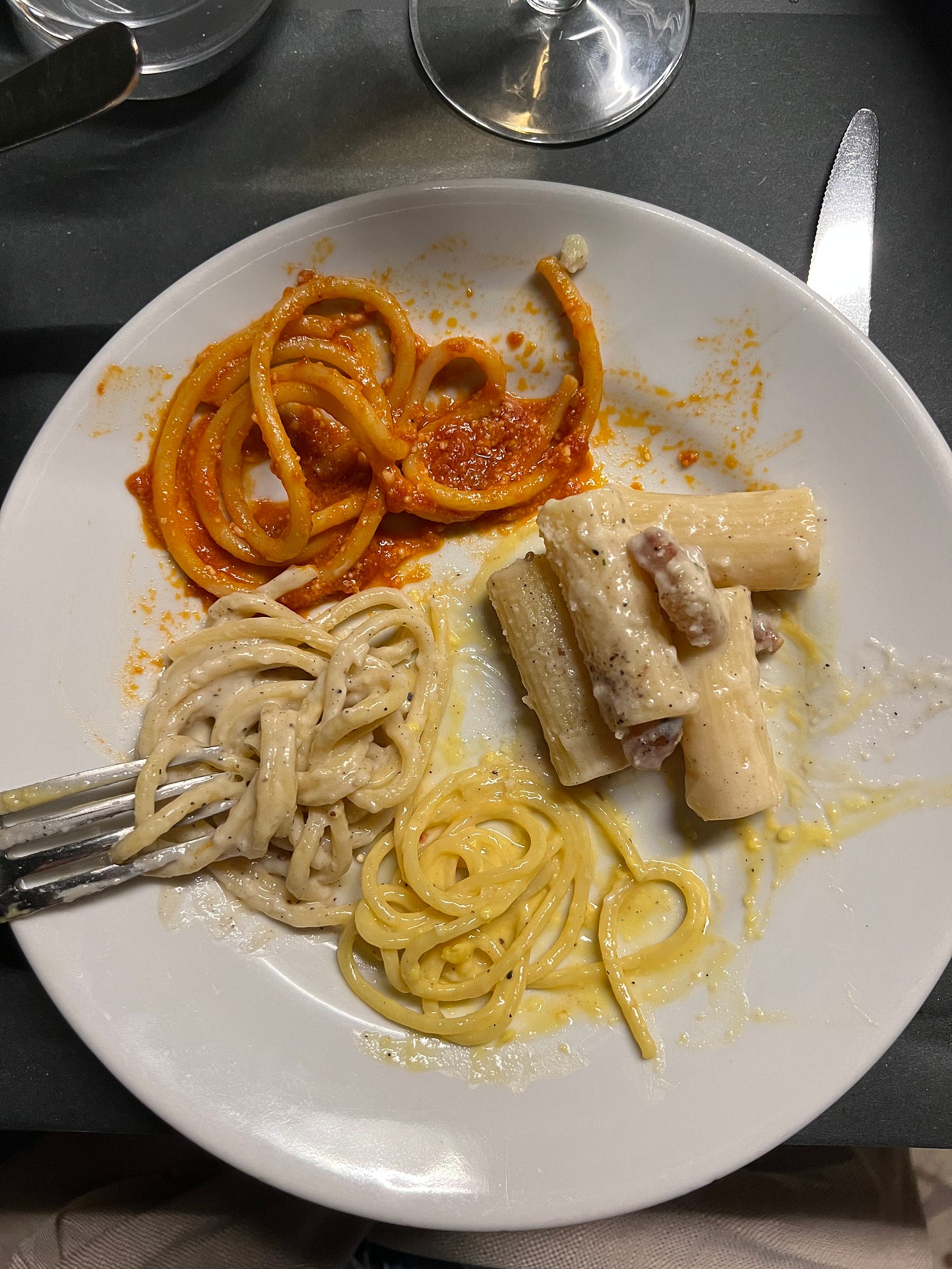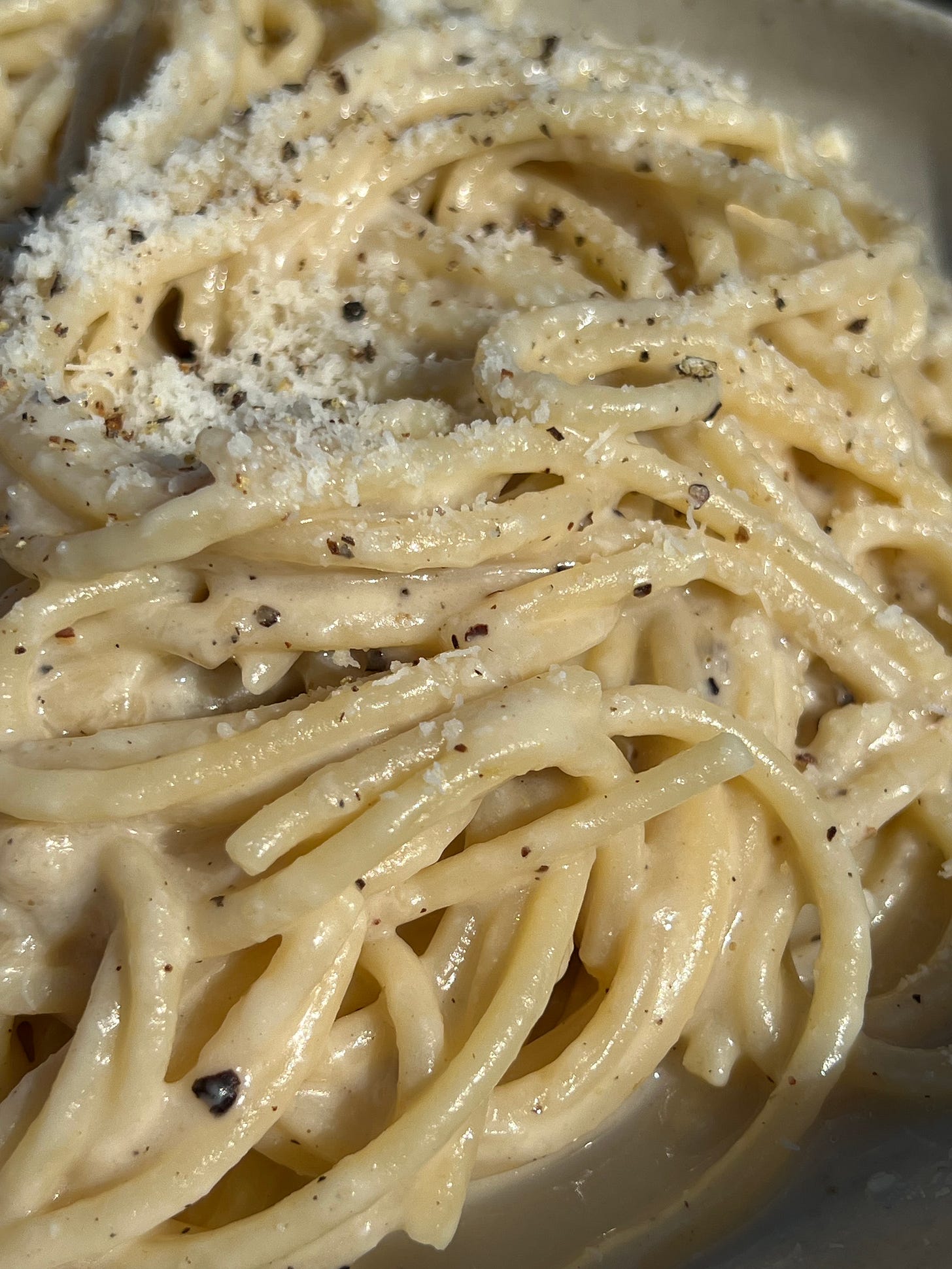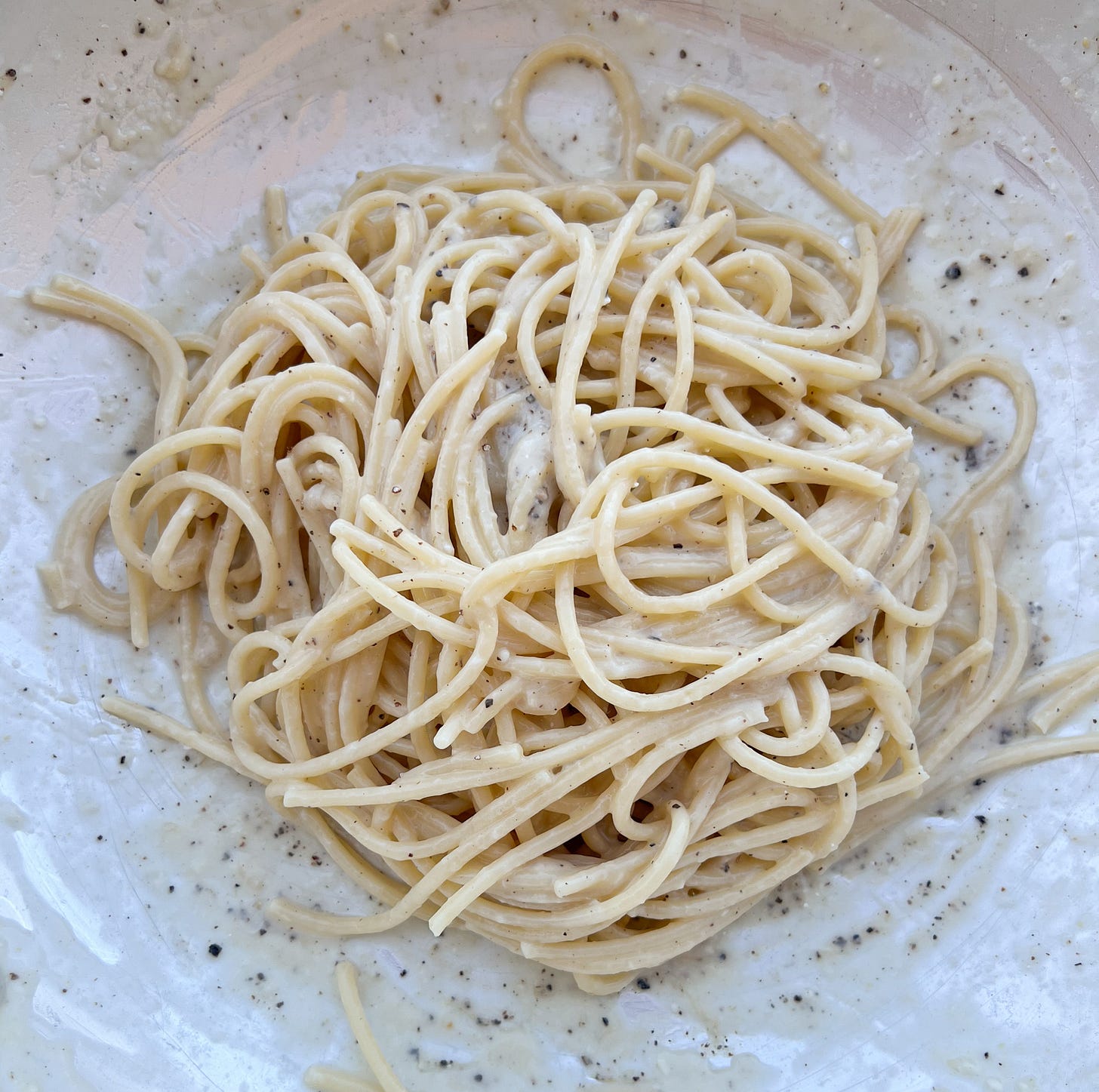Roman Mother Pastas in All Their Stubborn Glory
We are rolling out a Roman Pasta series through October! You're welcome. Cacio e Pepe sets the foundation and therefore, is the first to hit.
Want to really feel like you’re in Rome? We have Lazio (the region surrounding Rome) wine pairings at the end of the article.
If you’ve been to Rome, chances are you’re already familiar with the four classic pastas that locals and tourists alike slurp down at trattorie and osterie dotted throughout the city. The simplist among them, literally translated to “cheese and pepper” would be cacio e pepe. Add guanciale, and now we’re talking alla gricia. Add some egg, and we’ve arrived at the ultra-rich carbonara. Swap out the egg for pomodoro to reach the crescendo of all’amatriciana. These dynamic four are known as the Roman mother sauces, each transforming just a few ingredients into one of the most luxurious and renowned pasta dishes in the world.
For the next few weeks, one by one, we’re going to be rolling out recipes for each pasta along with tips on how to get it right, starting with cacio e pepe. Restaurants throughout Rome have very specific rules and regs for how they make the classics, each one claiming their method is the only way to do it right. Take from that what you will, but I’m surely not here to declare our method is the method. What I will say is that by following these basic techniques, I have achieved the most consistent results. Though simple, these pastas are unfortunately fuckupable! It’s really easy to get stringy cacio e pepe, over-salted gricia, scrambled egg carbonara, or amatriciana that’s way too acidic. After lots of yearning for the comfort pastas of Rome, and lots of missteps in an attempt to recreate them in my home kitchen, what lies below is my manifesto to unfuckupable pasta. So let’s start with a few foundational pieces.
Cacio e pepe, gricia, and carbonara are all about emulsification; in this case, the way the fat in the cheese and/or pork binds to the starch in the pasta and pasta water. There are a few tips that have changed the game for me in getting elite sauce texture.
First, you want to set yourself up to have high starch content in your pasta water. This means when you reach for a pot to boil your pasta, consider choosing a size that your pasta can easily swim in, but just barely. By creating a high pasta to water ratio, you’re getting the starchiest pasta water possible, thus your sauce binder is perfectly primed for cheese time.
In order to get a really creamy sauce, temperature matters. The way you incorporate your cheese matters. When you cut the pan’s heat matters. The type of pan you use, and how well it holds heat, matters. If cold cheese hits boiling water, it will seize, become stringy, and resist from melting into the sauce. Pay attention to your temperatures and timing as you’re testing. Read through the recipe top to bottom at least once before you you start cooking, so you already have a sense of where you’re going. We’re starting with cacio e pepe for a reason—if you nail the technique here, you’ll be well equipped to move forth. Cacio e pepe also uses the fewest ingredients and comes together really really fast. That means if you blow it the first time, you can have another round going within 10 minutes. I recommend starting small with your portions until you feel confident, and then scaling up from there. Do it a few times. Once you get it, you’ll get it!
Choose your pan wisely. In Italy there are pans specifically for finishing pasta and emulsifying sauce, called ‘padella per mantecare.’ The ones I’ve used are made of aluminum which heats quickly, and also drops heat quickly. I love my carbon steel and cast iron as much as the next guy, but I’ve found their heat retention to actually work against me when trying to get a creamy dreamy sauce (if the cheese is heated above 70C/158F, it strings!). Also, they’re heavy. Try to pasta-flick a 12” cast iron and tell me your wrist doesn’t bother you afterward. Actually, don’t do that please, preserve your joint health.
For me, an aluminum pan is elite for emulsifying—or mantecare—pasta sauces. After scouring the market for an American-made pan that was shaped and weighted correctly to no avail, I got lucky one day to peep a chef friend’s Instagram (shout out to Nick of Surf & Slice!) and there it was. The perfect pasta pan right here in LA. Nick linked me up to the Italian-made Pentole Agnelli, and my pasta game was brought right back to Emilia-Romana. If you’re serious about pasta, this pan will make you very happy. If you are freaked out by using aluminum, I’d recommend a stainless clad.
The recipe below, and the ones to follow over the next four weeks will say they serve 2-4. I realize that can be lightly annoying, so let me explain. If this is dinner alongside maybe a salad, it’s a portion for two people. If you’re running a whole italian-style meal start to finish with starters (antipasti), pasta (primo), a meat-based main (secondo), and veg sides (contorni), serving smaller portions of this for 4 would totally do the trick. They’re rich pastas, and not to say people won’t crave more, but a whole-ass Italian meal is a journey, not a race, and we must pace ourselves.
As with much Italian fare, these dishes take a little technique, but they’re not overly engineered, and the quality of the ingredients you use is everything. Pre-ground black pepper and powdered parm may have a place in your cabinet (but actually, you might need to convince me), but they certainly don’t here.
And while we’re talking about parm, traditionally, cacio e pepe doesn’t include it! Back in the day, this was strictly a pecorino dish. Makes sense when you realize that Romans (then, ancient Romans) have been making Pecorino Romano from the grazing sheep in Lazio for over two thousand years. Quite the history. Many chefs carry that tradition through to their recipes today, while others use as much as half parm. I actually don’t mind a light hand of parm and when including, typically use the ratio 3:1, pec to parm. If you find 100% pecorino too salty or pungent for your liking, substitute in some Parmigiano Reggiano. For what it’s worth, I do find pecorino a touch easier to integrate into the sauce. Whichever cheese you use, just make sure it is very finely grated.
Okay, now let’s make some pasta, shall we?!
Keep reading with a 7-day free trial
Subscribe to Cittavino & Co. to keep reading this post and get 7 days of free access to the full post archives.










